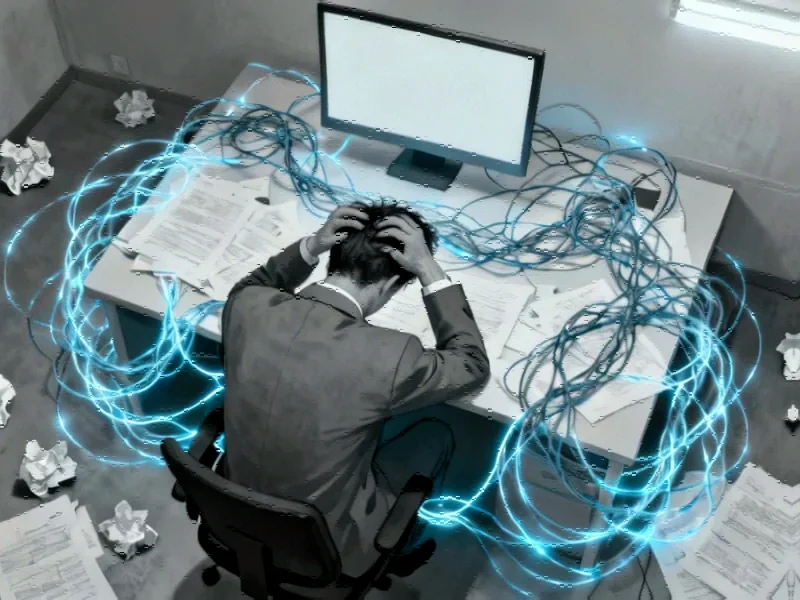The Pervasive Problem of Unchecked AI Output
In workplaces globally, a troubling phenomenon is emerging: employees are increasingly relying on artificial intelligence outputs without proper verification, creating what experts now term “AI workslop.” This refers to AI-generated content that appears polished but lacks substantive value, ultimately requiring significant correction and refinement by colleagues. Recent research reveals that a staggering 66% of employees using AI at work have utilized its output without evaluation, creating cascading inefficiencies throughout organizations.
The consequences extend beyond mere productivity loss. When Deloitte Australia recently issued a formal apology for a A$440,000 government report containing multiple AI-generated errors, it highlighted the reputational and financial risks of unchecked AI adoption. This case exemplifies how workslop creates downstream cleanup work that often goes unaccounted for in productivity metrics.
Quantifying the Workslop Drain
According to research from BetterUp Labs and Stanford Social Media Lab, 40% of U.S. workers received workslop from colleagues within a single month. Each incident required nearly two hours to resolve, translating to an estimated $9 million annual productivity loss for a 10,000-person organization. Beyond the tangible costs, recipients reported decreased perceptions of their colleagues’ reliability, creativity, and trustworthiness.
These findings align with broader industry developments showing that improper AI implementation creates significant organizational drag. The problem isn’t the technology itself, but how organizations integrate it into workflows without adequate safeguards and training.
The Transparency Deficit
Our research across 32,352 workers in 47 countries reveals concerning behavioral patterns. More than 61% of employees avoid disclosing their AI use, while 55% present AI-generated material as their own work. This lack of transparency creates organizational blind spots, making it difficult to identify and correct systematic errors.
While many employees report efficiency gains from AI, more than a quarter indicate increased workload, pressure, and time spent on mundane tasks. Half acknowledge using AI instead of collaborating with colleagues, suggesting that the technology may be undermining teamwork even as it promises efficiency. These invisible costs of AI adoption represent a significant challenge for modern organizations.
Strategic Solutions for Employees
Employees can take practical steps to minimize workslop generation:
- Evaluate AI appropriateness: Before using AI, ask whether it’s the best tool for the task. Many users skip this fundamental question, leading to inappropriate applications.
- Adopt an editorial mindset: Treat AI output as draft material requiring verification. Check facts, test code, and tailor content to specific contexts and audiences.
- Practice transparency: When stakes are high, disclose AI use and verification processes to maintain trust and demonstrate rigor.
These practices align with recent technology approaches that emphasize human oversight in automated systems. The most effective AI implementations combine technological capability with human judgment.
Organizational Responsibility and Governance
Employers play a crucial role in preventing workslop through strategic governance and literacy development. Key organizational measures include:
Developing clear AI guidelines: Organizations must establish when AI use is appropriate and what verification standards apply. This includes identifying high-value applications and defining responsibility structures.
Building AI literacy: With less than half of employees receiving AI training, organizations must close this gap. Effective training should cover selective use, accountability frameworks, and verification protocols. This educational approach complements related innovations in workforce development that prioritize competency alongside technological adoption.
Tracking outcomes: Organizations need systems to monitor AI implementation results, identifying workslop patterns and addressing systemic issues. This data-driven approach helps refine AI strategies over time.
The Human-AI Collaboration Imperative
The workslop phenomenon underscores that AI success depends less on technical capability than on implementation approach. Organizations that treat AI as a replacement for human labor rather than a collaborator tend to experience more workslop and associated costs.
Effective human-AI collaboration requires rethinking workflows to leverage both technological efficiency and human judgment. This balanced approach mirrors market trends toward hybrid intelligence systems that optimize the strengths of both human and artificial intelligence.
As organizations navigate this landscape, they must recognize that workslop stems from implementation choices, not inherent technology flaws. The solution lies in developing both technological systems and human capabilities simultaneously, ensuring that AI enhances rather than undermines workplace efficiency and collaboration.
The conversation around industry developments increasingly focuses on this balance between automation and human oversight. Organizations that master this integration will likely emerge as leaders in the AI-enhanced workplace, avoiding the productivity drain of workslop while harnessing AI’s genuine potential.
This article aggregates information from publicly available sources. All trademarks and copyrights belong to their respective owners.
Note: Featured image is for illustrative purposes only and does not represent any specific product, service, or entity mentioned in this article.



